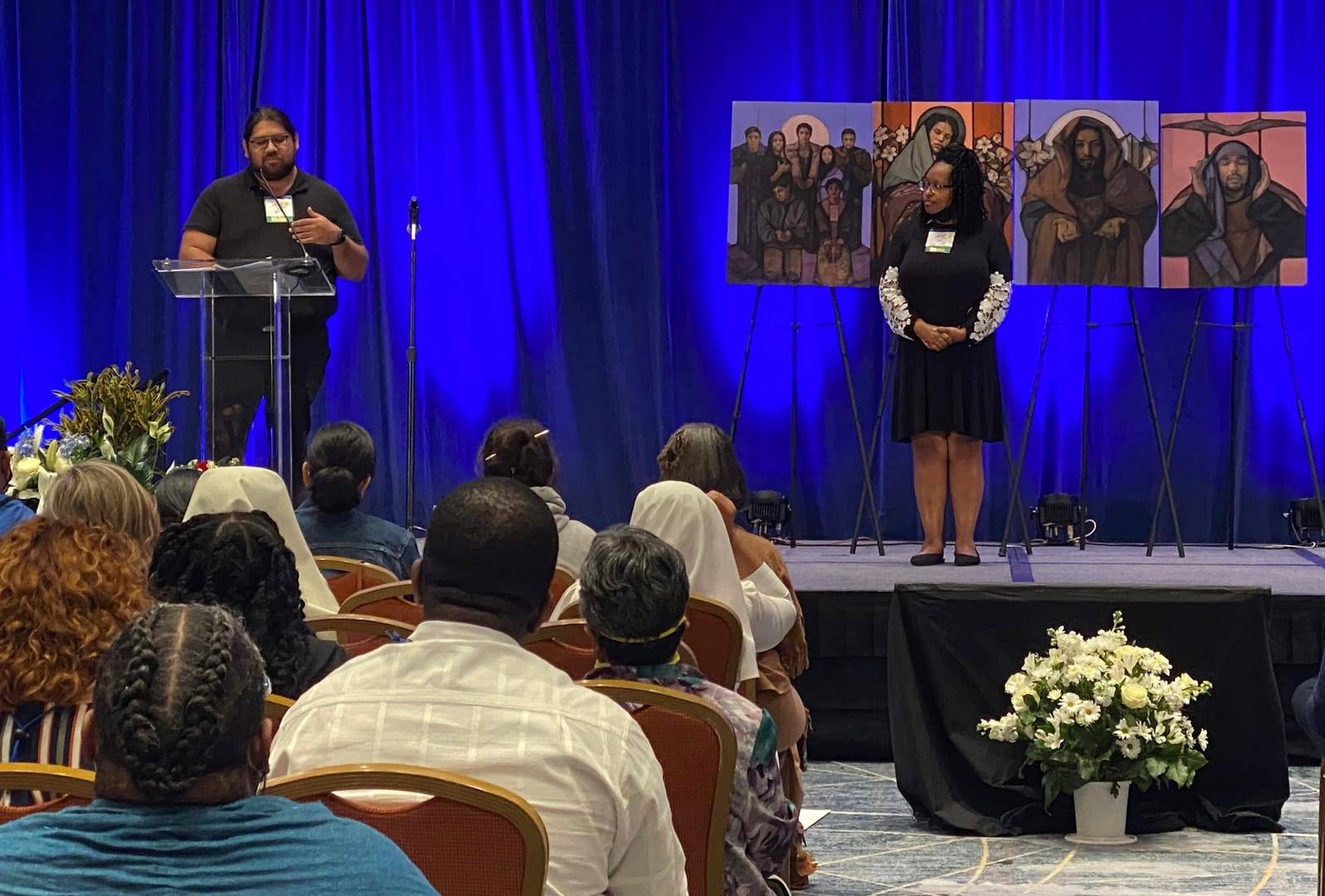BATON ROUGE, Louisiana — When meeting Louisiana chef John Folse, one immediately learns he is a man who believes in his Catholic faith.
Watching him walk, one also learns he’s a man who believes in miracles.
For 20 years, Folse walked with a limp in his left leg, the result of a debilitating injury to the calcaneus, or heel bone, in his left foot.
The incident happened on a Sunday afternoon after spending the day antiquing with his wife, Laulie. Folse recalled that she wanted to do a little redecorating, including removing a painting from a spot above a very tall cooking fireplace.
According to Folse, he was several feet high with one foot on the fireplace mantle and another on the ladder, when he removed the painting and began to turn. That’s when his life would change forever as the ladder began to fall. Quickly, he tossed the painting onto a nearby sofa and jumped.
“When I jumped I hit my hardwood floor and crushed my ankle, and I actually went into shock on the floor,” said Folse. “Let me tell you something, I could have died that night I was in the hospital.”
The following day, a doctor informed him of the extent of his injuries, explaining that of the “two worst breaks in the human body,” the back and the calcaneus, Folse had one of them.
“And when he said that, I fainted. It was the first time and the last time I ever fainted,” Folse told The Catholic Commentator, newspaper of the Diocese of Baton Rouge.
He said the doctor then explained how the entire weight of the body sits on the ball of the heel and “when you crush it, it’s like an egg, it just falls apart and you can’t put it back together.”
According to Folse, the doctor said “the only way we can put it back together is with steel,” resulting in painful walking for the rest of his life.
“(The doctor) was right about that,” said Folse, who must stand for hours working in the kitchen or catering events at his properties or walking through his food company’s 100,000-square-foot warehouse. “So I’ve always suffered pain a lot with it, but you just get used to it and then you just live with it.”
Then last year, Folse, who always dreamed of walking the Way of St. James, or El Camino de Santiago, was encouraged to join a co-worker and her friend who were already planning to make the trek in November. A fourth traveler later joined the group.
The plan, according to Folse, was for him to walk as long as he could each day and to catch up with his companions by vehicle if needed.
Weeks before the excursion, Folse said he received a call from a close friend in Baton Rouge, Sister Dulce Maria, a Mercedarian Sister of the Blessed Sacrament. She told him that the Blessed Mother had a gift for him in Fatima but that he had to pick it up in person. Filled with doubt about his ability to both complete the walk in Spain and travel to Portugal, Folse said he quickly dismissed the idea.
Later, though, while studying the map of the places the pilgrims would visit, Folse said he realized that the final portion of the planned 118-kilometer walk, which ends at the Cathedral of Santiago de Compostela, was only a three-hour drive from Fatima.
“I can’t even tell you the emotion that ran through my veins because I’m thinking to myself, ‘You know, this is impossible that I’m going to be doing this walk and here’s Fatima right here and Sister (Dulce) doesn’t know anything about my walk,'” he recalled.
Arriving in Spain for the start of his spiritual journey, Folse said he had resigned himself to walking one mile a day. But setting out on the first day, in silence and in prayer, he and his group completed 10 miles. According to Folse, an unprecedented snow day on the second day gave him the chance to rest his foot and his soul as he encountered others walking the El Camino and heard their stories.
“These pilgrims from all over the world had their own God story,” Folse recalled. “Some of them were divorced; some of them had a loss of a child; some of them (had suffered) bankruptcy; some of them had loss of faith.”
Recounting his own reason for being there and not believing he could complete the walk because of his crushed foot, Folse said he will never forget the words of a fellow pilgrim from Sweden: “That’s the way it works. You always just think you can’t do it and he (God) will just push you and push you and push you.”
Folse said the faith of those around him was astounding. Though the men and women came from different countries, spoke different languages and lived different lifestyles, Folse said they were “all there for the same reason: They were in search of God.”
He also said the scenic route, which included rest stops by streams, on mountainous terrain and in beautiful ancient churches, added to the aura of the spectacular hike.
“The whole experience was extraordinary for the beauty of the place, the beauty of the people,” said Folse of the special connection he felt to the Way of St. James, having grown up in St. James Civil Parish and attending St. James Church in St. James.
“People you met on the walk would say only two words,” recalled Folse. “‘Buen Camino’ — ‘good walk.'”
Throughout the trek, Folse said, he did not focus on the pain in his foot. His group reached the end of the Camino and joined hundreds of other pilgrims for Mass at the cathedral that evening. While at Mass, Folse said he received another gift from God — seeing the priests swing the cathedral’s massive incense ball known as the Botafumerio.
Folse said he considered the 10-day journey on the El Camino as “the door to Fatima.”
“And I can’t think of a better entrance because you have 10 days of silent prayer,” he said.
Once in Fatima, the group participated in the usual activities for the faithful including Mass at the Shrine of Fatima, a Marian procession, confession and a visit to “the apparition tree where the Blessed Mother had appeared” to the three children, Lucia Santos and her cousins Jacinta and Francisco Marto. Folse said during a visit to the home of the Marto children “the Blessed Mother gave me a special gift.”
“I saw a sign that said basement kitchen,” Folse recalled. “So, I walked down there and it’s kind of dark and there’s no windows there and I’m sitting on a little bench where his father scraped the pigs for the boucheries and in the picture, there is a light that looks like I’s from the sun and I know it’s the Blessed Mother.”
Folse said he also felt his own mother was the powerful force behind his trip to Fatima because of her devotion to Mary. When the excursion to Fatima was complete, Folse and his travel companions stopped at a gas station on the way out of town, and it’s a moment he’ll never forget.
“I started walking across the cement to the store and I said, ‘My God! I have no pain in my foot at all!'” Folse stated.
Turning to his companions, he showed off the movement in his previously stiff left foot. Then, Folse said he did something he hadn’t done in decades — run.
“Then when I’m running around that service station with this foot, wide open and no problems with it anymore, I’m thinking to myself how many times you doubt (like), ‘Eh, Blessed Mother’s not calling me,'” he said.
“There are miracles in your life all the time, you just have to be faithful,” Folse said. “Most people don’t believe in miracles. Let me tell you what, you should because everything you’re fighting in your life, you’re a prayer away from solving that problem.”
“You just have to keep that faith and know that that prayer is going to be answered. And sometimes it’s answered by not being answered. So you understand that part of it too.”
– – –
Van is a staff writer at The Catholic Commentator, newspaper of the Diocese of Baton Rouge.
Crux is dedicated to smart, wired and independent reporting on the Vatican and worldwide Catholic Church. That kind of reporting doesn’t come cheap, and we need your support. You can help Crux by giving a small amount monthly, or with a onetime gift. Please remember, Crux is a for-profit organization, so contributions are not tax-deductible.













